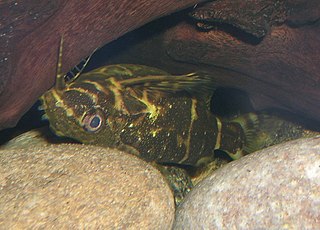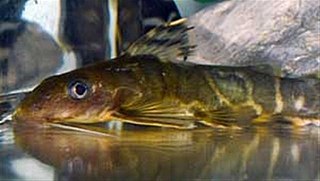
Synodontis nigriventris, the blotched upside-down catfish, is a species of upside-down catfish native to the Congo Basin of Cameroon, the Democratic Republic of the Congo and the Republic of the Congo.

Synodontis batensoda, the upside-down catfish, is a species of mochokid upside-down catfish. It is unevenly distributed in inland waters across Africa from Senegal to Ethiopia, and is also known as a squeaker or giant upside-down catfish. It was originally described by Eduard Rüppell in 1832 in the paper "Continuation of the description and figure of several new fish, in the Nile. p1-14".

Synodontis membranaceus, known as the moustache catfish, is a species of upside-down catfish that is native to northern Africa. It was first described by French naturalist Geoffroy Saint-Hilaire in 1809 as Pimelodus membranaceus, from specimens obtained in the Nile River. The species name membranaceus refers to membranes present on the barbels of the fish.

Synodontis nigrita, known as the false upside down catfish, is a species of upside-down catfish that occurs widely in northern Africa. It was first described by French zoologist Achille Valenciennes in 1840. The type specimen is in the Muséum National d' Histoire Naturelle de Paris.

Synodontis brichardi, known as Brichard's synodontis, is a species of upside-down catfish that is endemic to the Democratic Republic of the Congo where it occurs in the rapids of the lower Congo River. It was first described by Max Poll in 1959. The original specimens were obtained from the rapids at Kinsuka, Kinshaa, Zaire. The species name brichardi is named in honor of Pierre Brichard, an aquarium fish exporter who first discovered the fish.
Synodontis camelopardalis, known as the giraffe synodontis, is a species of upside-down catfish that is endemic to the Democratic Republic of the Congo where it is only known to occur in the Tshuapa River. It was first described by Max Poll in 1971. The original specimens were obtained in Eala, on the Ruki River in the central Congo River Basin. The species name camelopardalis refers to the giraffe, Giraffa camelopardalis, in reference to the coloration of the fish.

Synodontis clarias, known as the red tailed synodontis, or the mandi, is a species of upside-down catfish that occurs widely in the waters of northern Africa. It was first described by Swedish zoologist Carl Linnaeus in 1758 as Silurus clarias. The original specimens were obtained in Egypt, near Cairo. The meaning of the species name clarias is not certain, but may possibly have been used to mean "bright" or "clear".

Synodontis filamentosus, known as the longfin synodontis, is a species of upside-down catfish that is native to the basins of the Nile, Volta and Niger Rivers as well as the Chad Basin. It was first described by British-Belgian zoologist George Albert Boulenger in 1901, from specimens obtained near the mouth of Lake No, on the White Nile in Sudan. The species name filamentosus comes from the elongated rays of the dorsal and caudal fins.

Synodontis geledensis, known as the Geledi squeaker, is a species of upside-down catfish that is native to Ethiopia, Kenya and Somalia where it can be found in the Lorian Swamp, the Shebelle and Ewaso Ng'iro rivers. It was first described by German zoologist Albert Günther in 1896, from specimens obtained near Geledi, on the Shebeli River in east Africa. The species name geledensis comes from Geledi, Somalia, the location where the first specimens were first found.

Synodontis guttatus is a species of upside-down catfish that is native to the Niger River basin of Nigeria. It was first described by German ichthyologist Albert Günther in 1865, from the Niger River. The species name guttatus is the Latin word for "spotted", referring to the spots appearing on the fins and body of the fish.
Synodontis ilebrevis is a species of upside-down catfish endemic to Zambia, where it is only known from Lake Tanganyika. It was first described by Jeremy John Wright and Lawrence M. Page in 2006, from specimens collected from Lake Tanganyika at Cape Chaitika, Zambia. The species name comes from the Latin word "ile", meaning intestine, and the Latin word "bevis", meaning short, and refers to the relatively short gut of this species.

Synodontis leopardinus, known as the leopard squeaker, is a species of upside-down catfish that is native to the Cunene, Okavango and upper Zambezi Rivers. It was first described by Jacques Pellegrin in 1914. The original specimens were obtained in Barotsés, on the Zambezi River in Zambia. The species name leopardinus means "leopard like", referring to the fish's small black spots on a yellowish body.

Synodontis obesus, known as the Coas synodontis, is a species of upside-down catfish that is native to the coastal drainages of Cameroon, Ghana, Nigeria and Togo. It was first described by British-Belgian zoologist George Albert Boulenger in 1898. The species name obesus is derived from the Latin word obesus, meaning "fat".

Synodontis ocellifer, known as the ocellated synodontis, is a species of upside-down catfish native to the rivers of northern and western Africa. It has been reported in 10 countries, including Burkina Faso, Cameroon, Chad, Gambia, Ghana, Guinea, Mali, Niger, Nigeria, and Senegal. It was first described by Belgian-British zoologist George Albert Boulenger in 1900, from specimens collected in Kunchow Creek, in Gambia. The species name ocellifer comes from the Latin word ocellus, meaning "eye", and the Latin word ifer, meaning "to carry", which refers to the black spots, possibly with white centers found on the sides.

Synodontis omias is a species of upside-down catfish native to the Niger River basin of Guinea, Mali, Niger and Nigeria. It was first described by German-born British zoologist, ichthyologist, and herpetologist Albert Günther in 1864, from a specimen collected in Jebba, Nigeria, on the Niger River. There have been very few specimens of this species identified, and it may be the same species as S. budgetti from the Upper Niger.

Synodontis resupinatus is a species of upside-down catfish that is native to the Niger basin and the Bénoué River of Cameroon, Mali, and Nigeria. It was first described by British-Belgian zoologist George Albert Boulenger in 1904, from specimens obtained near Lokoja, Nigeria.

Synodontis soloni, known as the scissortail synodontis, is a species of upside-down catfish that is endemic to the Democratic Republic of the Congo where it is found in the Ubangi River and the rapids just below Stanley Pool. It was first described by British-Belgian zoologist George Albert Boulenger in 1899, from the Congo River in what is now the Democratic Republic of the Congo. The species name soloni is a patronym and in memory of Alexandre Solon, who assisted with the collection of fish.

Synodontis sorex is a species of upside-down catfish that is widely distributed in the rivers of northern Africa. It was first described by German zoologist Albert Günther in 1864, from specimens obtained in the upper Nile River, near Khartoum, Sudan. The species name sorex comes from the Latin word for shrew or shrew-mouse, the allusion was not explained. It possibly describes the pointed snout or the long, slender teeth.

Synodontis xiphias is a species of upside-down catfish that is native to the Niger River basin of Nigeria. It was first described by German ichthyologist Albert Günther in 1864, from specimens obtained in the Niger River. The species name xiphias comes from the Greek word xiphos, meaning sword, which refers to the long snout that was observed on the stuffed type specimen.

Synodontis zambezensis, known as the brown squeaker, the korokoro, or the plain squeaker, is a species of upside-down catfish that is native to the middle and lower Zambezi River system of Eswatini, Mozambique, South Africa, Tanzania, Zambia and Zimbabwe. It was first described by German naturalist and explorer Wilhelm Peters in 1852, from specimens collected in the Zambezi River in Mozambique. The species name zambezensis is derived from the Zambezi River, where this species is found.


















